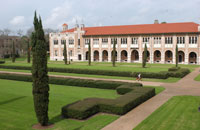Pediatric Cardiovascular Bioengineering Lab Research



Research Projects
The Effect of Substrate Stiffness on Cardiomyocyte Excitability and Ion Currents
The stiffness of myocardial tissue changes significantly during development and at birth, concurrent with significant changes in contractile and electrical maturation of cardiomyocytes. Previous studies by our group have shown that Cardiomyocytes generate maximum contractile force when cultured on a substrate with a stiffness matching that of native cardiac tissue. We hypothesized that substrate stiffness also affects ionic currents during cardiomyocyte action potentials. Neonatal rat ventricular cardiomyocytes (NRVMs) were isolated and cultured on polyacrylamide gels of varying elastic modulus (1, 5, 10, 25, and 50 kPa). Individual NRVMs were patch clamped in current-clamp mode, and action potential voltages were recorded. No significant difference was observed in the spontaneous beating rates of NRVMs on gels of varying stiffness. However, action potential decay times were significantly lower for NRVMs cultured for 7 days on gels of 10kPa, approximately the elastic modulus of native cardiac tissue, compared to gels of 1 kPa and 50 kPa. Action potential voltage curves from NRVMs on 10 kPa gels generally had a reduced plateau phase resembling adult rat cardiomyocytes, while action potentials from 1 kPa gels showed a significant plateau, resembling freshly isolated NRVMs. The results of these experiments may explain functional differences in cardiomyocytes due to changes in the elastic modulus of the extracellular matrix, as observed during development, in ischemic regions of the heart after myocardial infarction, and during dilated cardiomyopathy.

